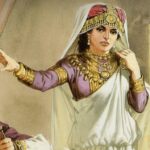Ammianus Marcellinus was born around 330 CE in Antioch, the capital of Syria. He was a historian and Roman commander of Greek origin. He took part in the battles against the Persians, Alemans and Goths. He is said to be the last great historian of antiquity and Rome.
Ammianus was very proud of his city (Antioch), “a city known to all the world, and without a rival, so rich is it in imported and domestic commodities”1. Not much is known about the life of Ammianus, and he carefully disregarded the events he had witnessed and stepped into the shadows.
He came from a middle-class family, his father was a city clerk or a military officer. Until the age of about 20, Ammianus lived in Antioch. He received a thorough humanistic, Greek and Latin education. He must have known the works of Homer, possibly of Hesiod, Simonides, Theognis, Sophocles and Euripides, and he was very familiar with Cicero from Latin writers. Perhaps he also knew the Persian language.
About 350 CE became a member of the Imperial Guard, the so-called protectores domestici. In 353 CE he was assigned to protect Ursicine, the cavalry commander stationed at the fortress of Nisibis east of the Euphrates, on the border with Persia.
In 355 CE together with Ursicinus he went to Milan at the call of Emperor Constantius II, and from there to Gaul, where Ursycyn smashed the troops of the usurper Silvanus. It was then that came into contact with the future emperor, then holding the office of Caesar, Julian the Apostate. The next five years he spent in Mesopotamia fighting the Persians, among other things he took part in the defence of the Amida fortress. His accounts of the arrival of the Huns to Europe also date from this period. He also described their customs, among others sitting on horses during the proceedings.
It is not known what happened with Ammianus in 360-363 CE, but in March 363 CE. he was already in the retinue of Emperor Julian the Apostate. He took part in the Battle of Ctesiphon on June 26, 363 CE, and after making peace, he returned to Antioch.
For the next several years, until around 380 CE he spent dividing his time between travelling (he visited Egypt, Greece, Thrace and the countries of Asia Minor) and a stay in his hometown. He was a writer and perhaps also worked as an attorney.
About 380 CE he moved to Rome, where he began to write his life’s work: Res gestae. This item concerned the history of Rome covering the years from the reign of Emperor Nerva (96 CE) to 378 CE. Only part of the work covering the period 353-378 CE has survived to the present day (books XIV-XXXI). It consisted of 31 books and was supposed to be a continuation of “Historiae” Tacitus.
It is the most important historical source for this period due to the objectivity and breadth of the presentation of the social life of the late empire. It also contains numerous geographic descriptions. Ammianus Marcellinus was the last great historian of antiquity.
The exact date of Ammianus’ death is unknown, some fragments of Res gestae may indicate events from 395 to 398 CE.
It is worth adding that Ammianus believed in gods, and his student and friend was John Chrysostom.






